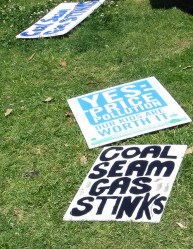Given a lump of coal or a tank of natural gas to burn for energy, there’s no question which is the better choice for the environment. As David Roberts noted earlier this year, utilities switching to cheaper natural gas is one of the factors contributing to the U.S.’ recent decrease in CO2 emissions. Good news.
There is, of course, a but. It is unclear how big the overall benefit of a switch to natural gas is if the switch relies on fracked gas. During the process of fracking, some amount of gas escapes into the atmosphere — mostly methane, which is 20 times more effective at retaining heat than carbon dioxide. The amount that generally escapes is debated, ranging from 0.2 to 2 percent. That latter figure would be … bad.
So is this, via the Los Angeles Times:
[R]eported findings of methane, carbon dioxide and other compounds at more than three times normal background levels have stirred new controversy in eastern Australia over the pros and cons of boosting natural gas output by “fracking,” a process that blasts sand, water and chemicals into deep underground wells.
Researchers from Southern Cross University took mobile air testing equipment to the Tara gas field near Condamine in Queensland to measure the ambient gas content. They found more than three times the level of toxic gases than expected, based on the industry’s claim that leakage from the wellheads is “negligible.”
“The concentrations here are higher than any measured in gas fields anywhere else that I can think of, including in Russia,” Damien Maher, a biochemist who helped conduct the tests, told the Sydney Morning Herald.
Normal methane levels in the area are 2 parts per million. The researchers found 6.89 parts per million near the fracking sites. Some scientists think the release may not be from the drilling system, but rather “fugitive” seepage from the mile-deep drilling area through displaced soil. If that is the case, the scenario is even worse, meaning that it could be almost impossible to contain the leaks.
We’ll note: This is one study in one specific location in Australia. There are a myriad of reasons that levels of methane and other greenhouse gases might have been higher than normal. And just because it’s happening in Australia — which is allllllll the way on the other side of the world — doesn’t mean that it happens here. Australia is vastly different from the United States. For example, it has a carbon tax, putting pressure on energy providers to use less-carbon-intensive forms of energy production, such as natural gas. Meaning that those who produce natural gas have an added incentive to protect its production.
And in that, America and Australia are awfully similar.
Rick Wilkinson, chief operating officer for the Australian Petroleum Production and Exploration Assn., said the findings were premature and biased.
“Incomplete research from Southern Cross University academics this week lacks the basics of scientific rigor,” Wilkinson said in a statement. “The claim that large-scale fugitive gas emissions are a result of coal seam gas production, before they even do their research, seems to indicate a bias against coal seam gas.”
Even down under, we see, political debate is plagued by releases of noxious gas.




